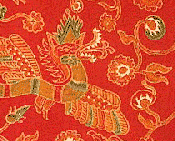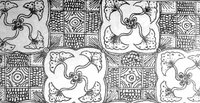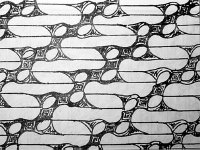 3. Batik Art from Cirebon.
3. Batik Art from Cirebon.
Cirebon located in the North coastal area too, but in West Java province. And, it makes acculturation between Cirebon culture and art with foreign culture and art too.
But Cirebon has more influence from Islam art and culture, such as: Arabic calligraphy and buroq. Beside Islam culture and art, Chinese and European culture & art appear too in Cirebon batik motif, such as krisan flower and grape plant from Holland. Yogyakarta and Surakarta style influence Cirebon batik motif too.
Cirebon batik use color :
a. Blue and white color.
b. Red and white color.
c. Red, white and green color.
 2. Batik Art from Pekalongan.
2. Batik Art from Pekalongan.
Pekalongan located in the North coastal area of East Java province. It makes acculturation between Pekalongan culture and art with foreign culture and art.
Batik motif from Pekalongan influenced by Chinese culture and art.
Chinese motif often appears in Pekalongan batik style, such as:
- Liong : Chinese dragon.
- Phonixk bird: A bird with long tail and wing fur.
The color of Pekalongan batik disposed with bright and merry color, such as red.
Batik as indonesian painting art in Java
 This is my article more about batik as painting art. Batik has a lot of function. You can use batik as clothing, unique wallet, home decoration, gift to some one you love and still much and much more. Batik can be mixed and combine with another goods or another arts with easy, because batik motif or style very dynamic also elegance.
This is my article more about batik as painting art. Batik has a lot of function. You can use batik as clothing, unique wallet, home decoration, gift to some one you love and still much and much more. Batik can be mixed and combine with another goods or another arts with easy, because batik motif or style very dynamic also elegance.
In Java (Indonesia), there are 3 famous batik motif :
1. Batik Art from Surakarta and Yogyakarta
2. Batik Art from Pekalongan
3. Batik Art from Cirebon.
Here, the description of each batik art.
1. Batik Art from Surakarta and Yogyakarta
Batik art from Yogyakarta and Surakarta has close relation. From the history in the past, batik motif in Yogyakarta (empire / kraton) came from Surakarta (empire / kraton). So, Surakarta is the root of Yogyakarta batik motif. Generally, batik art from Surakarta and Yogyakarta use simple colour, such as :
- brown (rather red)
- black (rather blue)
- white (main colour of textile)
In traditional and classic batik from Yogyakarta and Surakarta, they use natural substance colour from root, gum, tree skin or leaves, such as : brown colour from Soga tree, dark blue colour from Nila leaves.
See the picture of Batik Art from Surakarta and Yogyakarta in here and here.
Batik art motif from Yogyakarta and Surakarta part 2





 This is the continue about batik art motif/style from Yogyakarta and Surakarta.Just click the image to know the name of the motif/style.
This is the continue about batik art motif/style from Yogyakarta and Surakarta.Just click the image to know the name of the motif/style.
Batik as indonesian textile painting art




 Batik is generally thought of as the most quintessentially Indonesian textile. Motifs of flowers, twinning plants, leaves buds, flowers, birds, butterflies, fish, insects and geometric forms are rich in symbolic association and variety; there are about three thousand recorded batik patterns.
Batik is generally thought of as the most quintessentially Indonesian textile. Motifs of flowers, twinning plants, leaves buds, flowers, birds, butterflies, fish, insects and geometric forms are rich in symbolic association and variety; there are about three thousand recorded batik patterns.
The patterns to be dyed into the the clothe are drawn with a canting, a wooden 'pen' fitted with a reservoir for hot, liquid wax. In batik workshops, circles of women sit working at clothes draped over frames, and periodically replenish their supply of wax by dipping their canting into a central vat. Some draw directly on the the cloth from memory; others wax over faint charcoal lines.
There are some famous batik motif, such as Yogyakarta and Surakarta motif. The pictures above are some motif from Yogyakarta and Surakarta style. Just click the image to know the name of the motif. You can mix and use batik as decoration or clothes or something else. Javanese batik as one of the best painting textile art with elegance ethnic style. to be continued....
Wayang kulit - ethnic carving shadow puppet

 Wayang theatre is considered to be a highlight of Javanese culture. Over the centuries its religious character has increasingly developed into a distinct art form; foreign influences introduced new stories, characters were added, and new refined styles were developed at the courts.
Wayang theatre is considered to be a highlight of Javanese culture. Over the centuries its religious character has increasingly developed into a distinct art form; foreign influences introduced new stories, characters were added, and new refined styles were developed at the courts.
There are various types of wayang, but, in Java, the most important is the wayang purwa, which uses kulit (flat cut-outs of painted leather puppets) whose shadows are projected on a large white screen. Wayang purwa makes use of the purwa repertoire: the oldest stories about cosmic events and divine will are represented; the course of events is seen as being predestined, part of a cosmic law.
The Javanese word purwa means ‘beginning’ or ‘first’ and derives, probably, from the Sanskrit parwan, a word used to denote the chapter of the Mahabharata.
The making of shadow puppets is a long and painstaking process. Skin of a female buffalo of about four years of age, the ideal type for texture and strength, is dried, scraped and cured for up to ten years to achieve stiffness and eliminate warping and splitting.
On maturity, skin are carved and pierced to fashion the required character. This technique involves extensive knowledge of iconography and physiognomy, since all lines – angles of the head, slant of the eyes and mouth, profile of the body – are specific to the the character.
When carving is completed, the traditional pigments including powdered burnt bone for white, lampblack, indigo, yellow ochre and cinnabar for red in a gelatinous medium mixed from dried egg-white. Gold leaf and pigment are applied in a medium of protein glue derived from fish bones.
The cempurit, or manipulating rods, are made of buffalo horn, while the studs attaching the jointed arms to the torso are of metal (sometimes gold), bone, bamboo or, in rare courtly examples, gold studded with diamond.
Source : www.semarweb.com




